Thanksgiving History and Lore
Thanksgiving is a “food” holidaywhich chronicles the history of America.
The last Thursday in November has long been fixed in our nation as a day to come together, slow down our hectic lives, and celebrate time-honored traditions. It has always been a day to gather family and friends together to join in a meal and reflect on what we have to be thankful for, whether small or large. The Thanksgiving dinner symbolizes the bounty of good things, not; only food, we have been blessed with. It is a day in which new immigrants and the young learn to become part of the American fabric while the elderly and long standing citizens pay homage to their past history and remembrances. Although the basic meal and celebration is similar for all Americans, side dishes and activities differ from family to family. In every household it is a day eagerly anticipated, a day when belts become too tight, and a day when someone falls asleep watching a long football game after dinner.
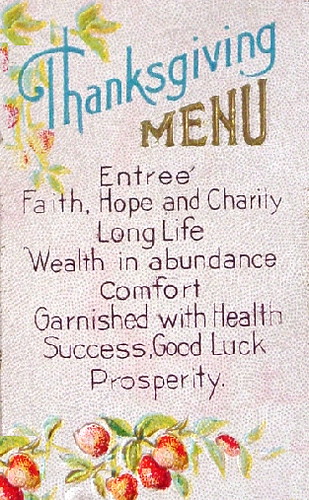
Man has long believed that spirits or gods controlled the outcome of one’s harvest. Harvest celebrations to honor gods have been held since long before the establishment of formal religions. Once religions were formed, paying homage to the gods of the harvest became an important part of the culture. The Greeks honored Demeter, goddess of grains, at an autumn festival, Thesmosphoria. The Romans held the fall festival Cerelia to honor Ceres, goddess of corn, when pigs and fruits were offered to her. Harvest festivals continued well after the fall of the Roman Empire throughout the world. In England, The Harvest Home celebration was held in the fall after the fields had been harvested.The Puritans transformed and brought the fall harvest celebration to America where it was eventually transformed into the holiday we know today. In 1609, the Puritans left England for Holland to flee religious prosecution. The Puritans became worried their children would come to adopt the ways of the Dutch, which they considered frivolous and so they brokered a deal with the Merchant Adventurers, a group of English investors, to provide the sea passage to America in exchange for seven years work. In America they would be able to start their own community. On September 6, 1620, 44 Puritans set sail on the Mayflower along with 66 strangers. These 110 became known as the Pilgrims and together they created the Mayflower Compact, an agreement that guaranteed the two groups would be united and equal. They decided to settle in an area that they named after Plymouth, England since it had a first-rate harbor and brook. When they landed, it was November, too late to grow crops, and less that 50 of the original 110 survived the subsequent harsh winter. The Pilgrims were concerned about the local Native Americans, but the nearby tribe was peaceful and on March 16, 1621 an Indian came into their village and said, “Welcome” to the Puritan’s surprise. This Indian's name was Samoset and he had learned English from fishermen off the cost of Massachusetts. He lived in a village along with Squanto, another Indian, who also spoke English and had spent some time in England after being rescued by English slavers. Squanto taught the Pilgrims invaluable lessons about the natural resources of their new land, teaching them how to tap the maple trees for syrup, which plants were edible, how to grow corn since the wheat they had brought from England would not grow in the rocky soil. By the next fall, the Puritans successfully harvested enough corn to store, fruit to dry, fish to salt, and meat to cure to sustain them over the long winter. Governor William Bradford proclaimed a day of thanksgiving to be hosted by the Puritans with the Indians as their honored guests. The feast lasted three days with games and displays of hunting skill. During the following year a bountiful harvest was not produced so Thanksgiving was not held. The third year, there was a severe drought and Bradford declared a day of fasting and praying and shortly thereafter it rained and a day of thanksgiving was proclaimed. These original Thanksgivings and subsequent ones held by the Puritans were holy days. In addition to the food and games, most of the day was spent in church service. The Puritans had long since abandoned celebrating many typical Christian holidays such as the saints days and Christmas which they rejected for being as blasphemous as holidays with pagan roots like Harvest Home. The Puritans believed ritual honoring of individuals served only to legitimize an ecclesiastical hierarchy, something fundamentally un-Christian. These Thanksgivings, however, eased the human need for celebration and joy while respecting their strict religious beliefs. Thanksgiving spread throughout the thirteen colonies and was heartily adopted by other Puritans and other immigrants who had traveled across the seas to find a new life. Although people had long given thanks and held harvest festivals, these celebrations became the first true American holiday
The first Thanksgivings were not well documented so it is not precisely known what was served. The dinner was more than likely eaten outdoors since no building would have been big enough to accommodate all of the Puritans and the 90 Indians. The menu probably included fish, shellfish, dried fruit, corn, berries, fowl and venison. Since it was the British who were in charge of cooking the meal, it can be safely assumed that they adapted their cuisine to use these new foods. 13 Pilgrim women were responsible for all of the cooking. British cooking placed the emphasis on meats, both game and fowl, while wheat or corn products and fruits were less important. Sweet foods were rare and would have only been prepared for special banquets such as Thanksgiving. Venison would have been the main game meat and Edward Winslow documented, in 1621, that the Indians brought 5 deer to the feast.
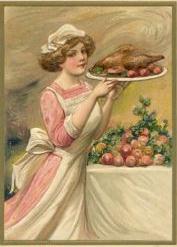
The fowl would have included geese, ducks, perhaps a swan and turkey. The turkey would have been wild, not domesticated at this point in history, and quite small compared to today’s average size. Some spices, reserved from the Mayflower voyage, would have been added to the dishes that were presented to the more important people at the dinner. There were no dairy products, as cows had not yet been brought over from Europe. Every dish, sweet or savory, would have been served at the same time, not in courses.
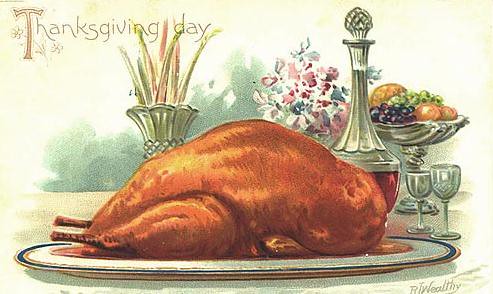
By the 1640’s, Thanksgivings across New England were proclaimed almost yearly but not without debate. Some ministers and governors felt that yearly celebrations would instill a feeling of overconfidence in God’s generosity. But by the 1660’s, Thanksgivings were firmly rooted in society and no governor tried to exclude the day from the calendar. The day was still arranged around a series of church services. By the early 1700’s, many communities ceased the afternoon service so people did not have to walk miles in the cold four times in one day. Since there was more time of the day that not was dedicated to prayer or work, games, dancing, ice skating, and sport games became an integral part of the afternoon. Later, as people began to move far and wide throughout the colonies, the annual pilgrimage home began to take form. Outside of New England, Thanksgiving was not widely celebrated. As the dinner portion of the day grew in importance and the harvest was usually bountiful, more pies were baked and more meats were roasted. Since, the early Colonialists did not celebrate Christmas, some of the usual treats were sorely missed and so plum pudding and mince pies became an essential part of the Thanksgiving menu, just as turkey pie and pumpkin pie had become. In 1705, the town of Colchester, Connecticut postponed Thanksgiving in order to wait for a shipment of molasses so the indispensable pumpkin pie could be made.Thanksgiving proclamations became vehicles for governors and ministers to endorse the Revolutionary War and the preservation of rights. In 1777, a national day of Thanksgiving was proclaimed for the 13 colonies after the colonial army defeated General John Burgoyne in the Hudson Valley. This put Thanksgiving well on its way to becoming an annual holiday. Even during the height of the Revolution when many families had to do without certain foods, Thanksgiving was celebrated from New Hampshire to Georgia. Because of the war colonialists had no access to raisins for mince pie or beef for roasts. But celery was just being introduced to the colonies from England and it was one of the first vegetables to be eaten raw. To celebrate the end of the Revolutionary War and the Treaty of Paris a Thanksgiving was proclaimed for November 28, 1782. A few years later Representatives from states outside of New England began to feel uncomfortable about imposing a northern holiday on their constituents. Also, Jeffersonian Democratic-Republican representatives were worried about crossing the line separating church and state, one of the principals upon which the young country was founded, because the holiday was still thought of as a predominately religious one. The Federalists, who thought churches were bulwarks of the social order that would support a strong central government, continued to support annual Thanksgivings. Presidents Washington, Adams and Madison all declared national days of Thanksgiving. Jefferson did not since, as he said, “civil powers alone have given to the President of the United States, and no authority to direct the religious exercises of his constituents.” New Englanders continued to celebrate Thanksgiving regardless of whether the President declared the day or not.The Thanksgiving preparations were begun weeks in advance. By the 1820’s, the turkey, which had been domesticated, had secured the place of honor at the table but chicken pies, geese and ducks were still served in conjunction. All these birds would have been suspended from a hook and roasted over the fire in such a way that the drippings fell into a pan and could be ladled back over the bird. The chicken pie was a major component of a New England dinner. Mutton, beef, venison and pork were served as well as after being roasted in a pot with a tight lid and set in the fire with embers on top. Some families served shellfish, abundant along the coasts, but they were not considered special enough for Thanksgiving since they were so readily available. Cranberry sauce, apple butter, and currant and gooseberry jellies were always prepared. All fruits were stewed since the early Americans rarely ate raw foods. Apple cider was the typical drink in New England, while Germans chose beer and French, wine. Thanksgiving vegetables were cabbage, potatoes, turnips, squash and of course, the pumpkin. These vegetables would keep all winter in the cellar. The pie, an English institution, was a major part of the meal. The mincemeat pie was begun well in advance because the beef had to be minced, the nuts shelled, the apples peeled, the raisins seeded and then everything minced and basted in molasses and brandy, after which 10 days were required for the for the pie to ripen. Trade had been well established making it easier to have molasses and tea. More pies were baked closer to the day, fruit pies, pumpkin and custard pies were among them.
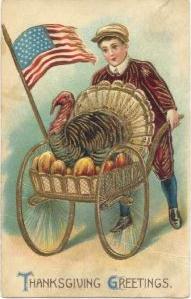
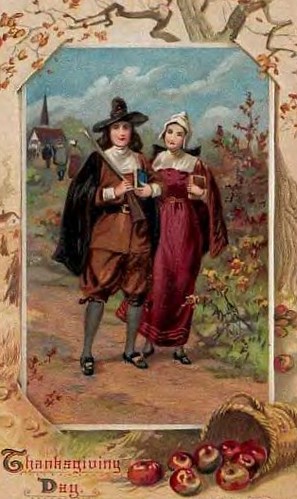

2 comments:
Its thanksgiving and there is fun and frolic all over but in all these merrymaking let us not forget the real purpose of the occasion. Lets all kneel and thank God for all that He has showered on us and for this beautiful life that he has graced us with. On this note do visit my Thanksgiving Blog sometime soon and share all the fun and joy of this beautiful festival.
That is so interesting! Thanks for all the info.
Post a Comment